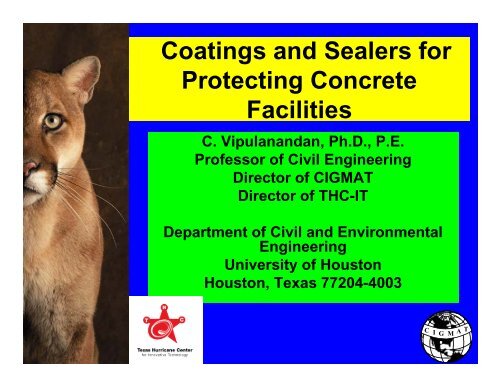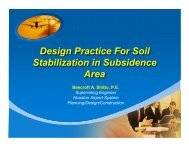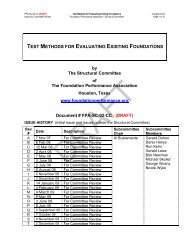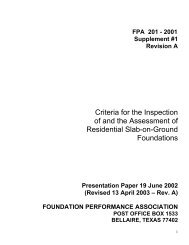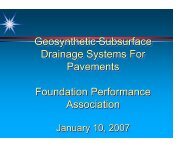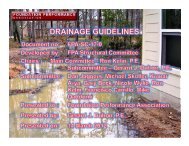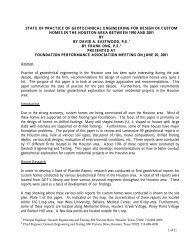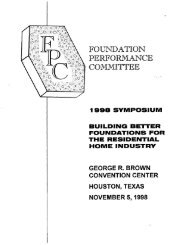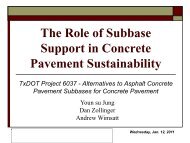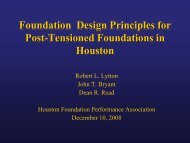Coatings and Sealers for Protecting Concrete Facilities - Foundation ...
Coatings and Sealers for Protecting Concrete Facilities - Foundation ...
Coatings and Sealers for Protecting Concrete Facilities - Foundation ...
You also want an ePaper? Increase the reach of your titles
YUMPU automatically turns print PDFs into web optimized ePapers that Google loves.
<strong>Coatings</strong> <strong>and</strong> <strong>Sealers</strong> <strong>for</strong><br />
<strong>Protecting</strong> <strong>Concrete</strong><br />
<strong>Facilities</strong><br />
C. Vipulan<strong>and</strong>an, Ph.D., P.E.<br />
Professor of Civil Engineering<br />
Director of CIGMAT<br />
Director of THC-IT<br />
Department of Civil <strong>and</strong> Environmental<br />
Engineering<br />
University of Houston<br />
Houston, Texas 77204-4003<br />
1994<br />
C I G M A T
How? When & Where? Why?<br />
1. Coating Forms A Barrier:<br />
2. <strong>Sealers</strong> Makes it Less<br />
Permeable<br />
3. Corrosive Environment<br />
4. Control Moisture Movements<br />
5. Easy to Apply, Rapid Results & Cost Effective<br />
(Saves $$)
What are the Technologies ?<br />
Corrosion Prevention / Maintenance<br />
(i) <strong>Coatings</strong><br />
(ii) Linings<br />
(iii) Chemical Spraying<br />
Structural Rehabilitation<br />
(i) Sliplining<br />
(ii) Cure-in-place-pipe (CIPP)<br />
(iii) Grouted Liners/Composites<br />
1994<br />
C I G M A T
OBJECTIVES<br />
The overall objective of this study was to investigate the<br />
per<strong>for</strong>mance of coated concrete (coatings, sealers) under<br />
various environments.<br />
The specific objectives are as follows:<br />
(1) to evaluate the applicability of the coatings on concrete<br />
surface under hydrostatic back pressure<br />
(2) to determine the long-term per<strong>for</strong>mance of coated<br />
concrete/clay brick with <strong>and</strong> without pinholes in sulfuric<br />
acid <strong>and</strong> salt environments.<br />
1994<br />
C I G M A T
Laboratory Study<br />
On<br />
<strong>Coatings</strong>
2. Comparison of Modified ASTM D 4541 <strong>and</strong> ASTM C 321 Tests<br />
Failure Strength from ASTM D 4541 Test (psi)<br />
0 0.5 1 1.5 2 2.5 3 3.5 4<br />
600<br />
500<br />
400<br />
300<br />
200<br />
100<br />
Failure Strength from ASTM C321 Test (MPa)<br />
Bonding Test Results in 6 Months<br />
0<br />
0<br />
0 100 200 300 400 500 600<br />
Failure Strength from ASTM C321 Test (psi)<br />
0 - 6 months<br />
Failure Strength from ASTM D4541 Test (psi)<br />
500<br />
400<br />
300<br />
200<br />
100<br />
4<br />
3.5<br />
3<br />
2.5<br />
2<br />
1.5<br />
1<br />
0.5<br />
Failure Strength from ASTM D 4541 Test (MPa)<br />
Failure Strength from ASTM D 4541 Test (psi)<br />
Failure Strength from ASTM C 321 Test (MPa)<br />
0 0.4 0.8 1.2 1.6 2 2.4 2.8 3.2<br />
Bonding Strength after One Year<br />
0<br />
0<br />
0 100 200 300 400 500<br />
Failure Strength from ASTM C 321 Test (psi)<br />
0 0.5 1 1.5 2 2.5 3 3.5 4<br />
600<br />
500<br />
400<br />
300<br />
200<br />
100<br />
Failure Strength from ASTM C 321 Test (MPa)<br />
Bonding Strength from 6 month to One Year<br />
0<br />
0<br />
0 100 200 300 400 500 600<br />
3.2<br />
2.8<br />
2.4<br />
2<br />
1.6<br />
1.2<br />
0.8<br />
0.4<br />
Failure Strength from ASTM C 321 Test (psi)<br />
Failure Strength from ASTM D4541 Test (MPa)<br />
6 months - 1 year<br />
After 1 year<br />
4<br />
3.5<br />
3<br />
2.5<br />
2<br />
1.5<br />
1<br />
0.5<br />
Failure Strength from ASTM D 4541 Test (MPa)
3. Bonding Failure Strength <strong>and</strong> Failure Types<br />
Failure Strength, psi<br />
Failure Strength, psi<br />
500<br />
400<br />
300<br />
200<br />
100<br />
500<br />
400<br />
300<br />
200<br />
100<br />
KWCL321<br />
KDCO4541<br />
KWCL4541<br />
KWCO321<br />
KDCL321<br />
KWCO4541<br />
KDCL4541<br />
KDCO321<br />
COATING K<br />
N = 22<br />
0 100% 0 100% 0 100% 0 100% 0 100%<br />
1 2 3 4 5<br />
Failure Type<br />
DDCO4541<br />
DDCL321<br />
DDCO321<br />
DWCO4541<br />
DWCL4541<br />
0 100% 0 100% 0 100% 0 100% 0 100%<br />
1 2 3 4 5<br />
Failure Type<br />
COATING D<br />
N = 24<br />
DDCL4541<br />
DWCL321<br />
DWCO321<br />
Failure Strength, psi<br />
Failure Strength, psi<br />
250<br />
200<br />
150<br />
100<br />
50<br />
TWCO4541<br />
TDCL4541<br />
TDCO4541<br />
TWCL4541<br />
0 100%0 100%0 100% 0 100% 0 100%<br />
1 2 3 4 5<br />
300<br />
250<br />
200<br />
150<br />
100<br />
50<br />
RDCO321<br />
RWCO321<br />
RDCO4541<br />
RDCL4541<br />
RDCL321<br />
RWCL321<br />
Failure Type<br />
RWCO4541<br />
TWCO321<br />
TDCO321<br />
TWCL321<br />
TDCL321<br />
COATING T<br />
N = 23<br />
0 100% 0 100% 0 100% 0 100% 0 100%<br />
1 2 3 4 5<br />
Failure Type<br />
RWCL4541<br />
COATING R<br />
N = 24
Field Study<br />
Vs.<br />
Lab Study
So<br />
Solution<br />
Models <strong>for</strong> Liquid Transport into Coated <strong>Concrete</strong><br />
<strong>and</strong> Calcium Leaching<br />
1. Physical Model<br />
Coating <strong>Concrete</strong><br />
Si<br />
S(t)<br />
Center Line<br />
Case 1: Liquid transport process<br />
without chemical reaction<br />
So<br />
Solution<br />
Coating <strong>Concrete</strong><br />
Reacted<br />
Area<br />
Si<br />
S(t)<br />
Center Line<br />
Case 2: Liquid transport process<br />
with chemical reaction
2. Modeling<br />
A. Assumptions:<br />
(1) the process can be modeled by second order differential equation<br />
2 2 2<br />
∂S<br />
⎛ ∂ S ∂ S ∂ S ⎞<br />
= D ⎜ + + ⎟<br />
2 2 2<br />
∂t<br />
⎝ ∂x<br />
∂y<br />
∂z<br />
⎠<br />
(2) the mass transfer coefficient is constant in coating film ( DCT ), non-reacted<br />
concrete cylinder ( DCO ) or reacted concrete area ( );<br />
r<br />
(3) there is no gradient of degree of saturation between bulk liquid <strong>and</strong> D<br />
coating surface;<br />
CO<br />
(4) coating film <strong>and</strong> concrete surface are in good contact;<br />
(5) coating film does not react with contacted liquid;<br />
(6) degree of saturation of solid is defined as .
B. Liquid Transport through Coating Film<br />
The second order differential equation in one dimension<br />
2<br />
∂S<br />
∂ S<br />
= D 2<br />
∂t<br />
∂x<br />
Boundary conditions:<br />
at x = 0 S = S<br />
x = l S = Si Solving equation (1)<br />
S −S<br />
CT<br />
S −S<br />
i<br />
CT<br />
0 = CT<br />
0<br />
x<br />
l<br />
CT<br />
0<br />
Consider the rate of mass transfer F<br />
F = −D<br />
CT<br />
CT ⎛ ρ dS ⎞<br />
⎜<br />
⎟<br />
⎝ dx ⎠<br />
(1)<br />
(2)<br />
(3)<br />
Coating Film<br />
So<br />
Si<br />
Solution <strong>Concrete</strong><br />
l
Assume that the rate of mass transfer F is a constant from time t to t + dt<br />
combining equation (2) <strong>and</strong> (3), the rate of mass transfer at time t is<br />
the concentration on the interface varying with time t can be represented<br />
by the exponential function<br />
Equation (4) becomes<br />
dS DCT<br />
CT CT CT<br />
() t = −DCT<br />
= ρ ( S0<br />
Si<br />
)<br />
F −<br />
dx l<br />
S<br />
CT<br />
i<br />
= S<br />
CT<br />
0<br />
( 1−<br />
e<br />
F<br />
() t<br />
−<br />
CT<br />
β<br />
t<br />
The amount of the substance transported through coating film from time t<br />
to t + dt is<br />
dWt t<br />
)<br />
D<br />
=<br />
l<br />
=<br />
2πRhF()dt<br />
CT<br />
ρ<br />
CT<br />
S<br />
CT<br />
0<br />
e<br />
−β<br />
CT<br />
t<br />
(4)<br />
(5)<br />
(6)<br />
(7)
Integrating equation (7) from time 0 to t<br />
W<br />
C. Liquid Transport in Coated <strong>Concrete</strong> Cylinder<br />
(a) Liquid transport without chemical reaction<br />
For mass transport in cylindrical media, the second order differential equation is<br />
φ t<br />
If the concentrate at the concrete surface is , the solution of the second order<br />
differential equation is<br />
Assume the surface concentration is:<br />
t<br />
2πRhρ<br />
=<br />
β<br />
CT<br />
CT<br />
∂S<br />
1 ∂ ⎛<br />
= ⎜rD<br />
∂t<br />
r ∂r<br />
⎝<br />
S<br />
CO<br />
CT<br />
0<br />
{ 1−<br />
exp(<br />
− β t)<br />
}<br />
CO<br />
φ(<br />
t)<br />
= So<br />
1<br />
D<br />
l<br />
∂S<br />
⎞<br />
⎟<br />
∂r<br />
⎠<br />
2 αnJ<br />
0<br />
( ) ( rαn<br />
)<br />
− D α t<br />
( Rα<br />
)<br />
CT<br />
CT<br />
−β<br />
t ( 1−<br />
e )<br />
( )<br />
2 ( D α t)<br />
()dt t<br />
2DCO<br />
S = ∑exp CO n<br />
exp CO n φ<br />
R<br />
J ∫<br />
∞<br />
n=<br />
1<br />
1<br />
n<br />
t<br />
0<br />
(8)<br />
(9)<br />
(10)
The solution of equation (10) is<br />
S<br />
S<br />
CO<br />
0<br />
The sorption rate is<br />
Wt<br />
2<br />
πR<br />
ρ<br />
Calculated Sorption Curves<br />
from equation (12)<br />
Numbers on Curves Are<br />
Values of<br />
J<br />
2<br />
1/<br />
2<br />
{ ( βr<br />
/ DCO<br />
) }<br />
2<br />
1/<br />
2<br />
( βR<br />
/ D )<br />
{ CO }<br />
2β<br />
J0<br />
( ) ( rαn<br />
)<br />
− βt<br />
+<br />
0 = 1−<br />
exp ∑<br />
J<br />
RDCO<br />
n 1 α<br />
0<br />
nJ1<br />
n<br />
∞<br />
=<br />
CO<br />
CO<br />
S<br />
CO<br />
0<br />
= 1−<br />
2<br />
βR<br />
/ D<br />
2<br />
1/<br />
2<br />
2J1{<br />
( βr<br />
/ DCO<br />
) } exp(<br />
− βt)<br />
2<br />
1/<br />
2<br />
2<br />
1/<br />
( βR<br />
/ D ) J ( βR<br />
/ D )<br />
CO<br />
CO<br />
0<br />
2<br />
{ CO }<br />
Mt/IIR 2 Co<br />
1<br />
0.8<br />
0.6<br />
0.4<br />
0.2<br />
0<br />
4<br />
+<br />
R<br />
2 ∑<br />
n 1<br />
∞<br />
=<br />
1<br />
( Rα<br />
)<br />
α<br />
0.5<br />
2<br />
n<br />
exp<br />
0 1 2 3 4 5<br />
(Dt/R 2 ) 1/2<br />
2 ( − D α t)<br />
CO n<br />
2 ( α −β<br />
/ D )<br />
exp<br />
n<br />
0.1<br />
CO<br />
2 ( − D α t)<br />
CO n<br />
2 { α / ( β / D ) −1}<br />
n<br />
CO<br />
0.01<br />
(11)<br />
(12)
Define<br />
λ<br />
CO<br />
= βR<br />
2<br />
/ D<br />
CO<br />
Approximating this relationship <strong>and</strong> considering an exponential function of the<br />
<strong>for</strong>m<br />
CO<br />
Wt<br />
2 CO CO<br />
πR<br />
ρ S0<br />
n<br />
⎪⎧<br />
⎡ ⎛ D ⎞ ⎤⎪⎫<br />
COt<br />
= ⎨1<br />
− exp⎢−<br />
λCO⎜<br />
2 ⎟ ⎥⎬<br />
⎪⎩ ⎢⎣<br />
⎝ R ⎠ ⎥⎦<br />
⎪⎭<br />
(13)<br />
Values of Parameter n from Curve Fitting<br />
λ CO n R<br />
0.01 1.006 0.999<br />
0.1 1.009 0.999<br />
0.5 1.042 0.999<br />
1 1.001 0.999<br />
5 1.346 0.999<br />
Comparison of st<strong>and</strong>ard curves<br />
<strong>and</strong> approximate solution<br />
Mt/IIR 2 Co<br />
1<br />
0.8<br />
0.6<br />
0.4<br />
0.2<br />
0<br />
1<br />
0.5<br />
0 1 2 3 4 5<br />
0.1<br />
(Dt/R 2 ) 1/2<br />
0.01
D. Verifications of Mass Transport Models<br />
Film Model<br />
Weight Change, g/cm 2 x10 2<br />
<strong>Concrete</strong> Models<br />
Weight Change, g/cm 2 x10 2<br />
10<br />
8<br />
6<br />
4<br />
2<br />
0<br />
0 500 1000 1500<br />
10<br />
8<br />
6<br />
4<br />
2<br />
Coating K (Dry <strong>Concrete</strong>) in D.I. Water<br />
Immersion Time, day<br />
Coating K (Dry <strong>Concrete</strong>) in D.I. Water<br />
KDCO11-6 mm<br />
KDCO16-3 mm<br />
KDCO5-0<br />
KDCO6-0<br />
0<br />
0 500 1000 1500<br />
Immersion Time, day<br />
KDCO11-6 mm<br />
KDCO16-3 mm<br />
KDCO5-0<br />
KDCO6-0<br />
Weight Change, g/cm 2 x10 2<br />
Weight Change, g/cm 2 x10 2<br />
20<br />
15<br />
10<br />
5<br />
Coating K (Dry <strong>Concrete</strong>)<br />
in 3% sulfuric acid<br />
KDCO13-13 mm<br />
KDCO-10-6 mm<br />
KDCO-9-6 mm<br />
KDCO15-3 mm<br />
KDCO4-0<br />
KDCO3-0<br />
0<br />
0 200 400 600 800 1000 1200 1400<br />
20<br />
15<br />
10<br />
5<br />
Immersion Time, day<br />
Coating K (Dry <strong>Concrete</strong>)<br />
in 3% sulfuric acid<br />
KDCO13-13 mm<br />
KDCO-10-6 mm<br />
KDCO-9-6 mm<br />
KDCO15-3 mm<br />
KDCO4-0<br />
KDCO3-0<br />
0<br />
0 200 400 600 800 1000 1200 1400<br />
Immersion Time, day
3. Calcium Leaching<br />
Assume the rate of calcium leaching from coated concrete is of<br />
the first order kinetic of the total calcium leached (C s )<br />
dC<br />
dt<br />
= α(<br />
kM C )<br />
(17)<br />
s<br />
c −<br />
Integrating Equation (17) at t = 0, C s = 0 <strong>and</strong> t = t, C s = C s<br />
C<br />
s<br />
= πR<br />
2<br />
hkC<br />
f<br />
( 1−<br />
e<br />
−αt<br />
)<br />
(18)<br />
The effect of pinhole sizes can be<br />
corrected by equation (16)<br />
s<br />
Calcium Leached, mg/cm 2 x10 -2<br />
200<br />
150<br />
100<br />
50<br />
Calcium leaching of Coating N coated<br />
wet concrete in 3% sulfuric acid<br />
NWCO12-0<br />
NWCO10-3 mm<br />
NWCO8-6 mm<br />
NWCO7-13 mm<br />
Model<br />
0<br />
0 100 200 300 400 500<br />
Immersion Time, day
CONCLUSIONS<br />
Based on the experimental results, the following observations<br />
are advanced<br />
(1) Hydrostatic Test: used to evaluate the applicability of<br />
coatings onto concrete under hydrostatic back pressure with<br />
a moisture emission of 536 mg/(s.m2) (9.49<br />
lb/(1000ft2.24h)). Many coatings tested in the study were<br />
successfully applied on to the concrete surface. Some<br />
coating developed blisters during the testing period.<br />
1994<br />
C I G M A T
(2) Chemical Test: coated concrete specimens with pinholes<br />
failed sooner than without pinholes <strong>and</strong> the time to failure<br />
depended on the type of coating <strong>and</strong> pinhole size. Based on<br />
time-to-failure analysis, the selected coatings can prolong the<br />
service life of concrete by 14 <strong>and</strong> 57 times without failure.<br />
Testing coated concrete specimens with pinholes is considered<br />
to represent the critical condition in the field.<br />
(3) Bonding Test: There was no direct correlation between<br />
bonding strength <strong>and</strong> chemical resistance of coated concrete.<br />
(4) Although coatings can be of the same base material the<br />
per<strong>for</strong>mance can be totally different. C I G M<br />
1994<br />
A T
Testing Composite Coating Systems with<br />
Silanes <strong>for</strong> <strong>Protecting</strong> <strong>Concrete</strong> Columns on the<br />
Galveston Causeway Project<br />
by<br />
C. Vipulan<strong>and</strong>an (Vipu) Ph.D., P.E.<br />
Center <strong>for</strong> Innovative Grouting Materials <strong>and</strong> Technology<br />
(CIGMAT)<br />
Department of Civil <strong>and</strong> Environmental Engineering<br />
University of Houston<br />
Houston, Texas 77204-4003
DOCUMENTS REVIEWED<br />
1. NCHRP Report 244:<br />
<strong>Concrete</strong> <strong>Sealers</strong> <strong>for</strong> Protection of Bridge Structures<br />
2. Florida Dot St<strong>and</strong>ard:<br />
Specifications <strong>for</strong> Road <strong>and</strong> Bridge Construction<br />
Section 413: Sealing <strong>Concrete</strong> Structure Surfaces<br />
3. Texas DOT Material Specifications<br />
Section 5. DMS-8110, <strong>Coatings</strong> <strong>for</strong> <strong>Concrete</strong><br />
Section 9. DMS-8140, <strong>Concrete</strong> Surface Treatment (Penetrating)
CIGMAT Test Programs<br />
1. Immersion Test (NCHRPR 244) (including Ca 2+ Leaching)<br />
(CIGMAT CT-1)<br />
2. Bonding Test (ASTM D 4541/CIGMAT CT-2)<br />
3. Thermo Cycling Test (Long-term Durability)<br />
4. Permeability Test (AASHTO T277-89)
OBJECTIVES<br />
(1) Evaluate the effectiveness of Silanes in reducing the<br />
chloride (NaCl) infiltration (Immersion Test)<br />
(2) Effect of Silanes on the per<strong>for</strong>mance of Latex Paints<br />
(Infiltration <strong>and</strong> Bonding)<br />
(3) Long-term per<strong>for</strong>mance of Latex paints under temperature<br />
cycling.<br />
(4) Chloride permeability of the uncoated <strong>and</strong> coated concrete
<strong>Concrete</strong><br />
Silane<br />
Silane 2<br />
<strong>Coatings</strong>/ Latex Paint<br />
MATERIALS<br />
TxDOT Class F. (concrete specimens were cured <strong>for</strong> 28 days)<br />
Silane 1<br />
Coating 1<br />
Coating 2
TESTING PROCEDURES<br />
<strong>Concrete</strong> Specimen Preparation<br />
(1) Water blasting at 1500 psi to remove loose material on the surface;<br />
(2) Drying <strong>for</strong> 2 days at room condition (23 ± 2 o C, 50 ± 5% RH);<br />
(3) Applying Silane on concrete at 25 psi;<br />
(4) Drying specimens <strong>for</strong> 7 days;<br />
(5) Applying Latex on Silane coated concrete <strong>and</strong> uncoated concrete;<br />
(6) Curing specimens <strong>for</strong> 4 days (room condition).
Immersion Test (Cylindrical Specimens)<br />
1) Cylindrical specimens were immersed in tap water <strong>and</strong> 15%<br />
NaCl solution <strong>for</strong> 21 days;<br />
2) Dry the specimens <strong>for</strong> 21 days;<br />
3) In order to study pinhole effects on water <strong>and</strong> salt penetration,<br />
1/8" pinholes were intentionally made on some of the<br />
specimens.
Bonding Test<br />
1) The ASTM D 4541 test method was used to determine the<br />
bonding strength of Latex to concrete with/without Silane;<br />
2) Prism specimens were coated in the same manner as the<br />
specimens <strong>for</strong> the immersion test;<br />
3) The specimens were cured in the room condition, tap water<br />
<strong>and</strong> 15% NaCl solution;<br />
4) Bonding strength was determined at the beginning <strong>and</strong> end<br />
of the immersion test.
Temperature Cycling Test<br />
1) Temperature cycling test was per<strong>for</strong>med on specimens<br />
coated with Sliane & Latex <strong>and</strong> Latex only;<br />
2) The maximum temperature was 120 o F;<br />
3) The specimens were at 120 o F <strong>for</strong> 3 days <strong>and</strong> at room<br />
condition <strong>for</strong> 1 day, then immersed in 15% NaCl <strong>for</strong> 3<br />
days. Repeat the process.<br />
4) Cylindrical specimens were used <strong>for</strong> the thermal cycle<br />
test.
Comparison of Batch 1 <strong>and</strong> Batch 2 <strong>Concrete</strong><br />
Batch<br />
1<br />
2<br />
Average<br />
Weight of<br />
Specimens<br />
(g)<br />
1559.36<br />
1636.21<br />
Density<br />
(lb/ft 3 )<br />
140.16<br />
147.07<br />
Density<br />
(kg/m 3 )<br />
2247.2<br />
2358.0
Comparison of Batch 1 <strong>and</strong> Batch 2 <strong>Concrete</strong> in Water <strong>and</strong> 15% NaCL<br />
Weight Change %<br />
2.5<br />
2<br />
1.5<br />
1<br />
0.5<br />
0<br />
Uncoated specimens in water<br />
<strong>and</strong> 15% NaCl solution<br />
Batch 1 in water<br />
Batch 1 in water<br />
Batch 1 in 15% NaCl<br />
Batch 1 in 15% NaCl<br />
Batch 2 in water<br />
Batch 2 in water<br />
Batch 2 in 15% NaCl<br />
Batch 2 in 15% NaCl<br />
0 5 10 15 20 25<br />
Immersion Time, days
Silane Coated <strong>Concrete</strong> in Water <strong>and</strong> 15% NaCl Solution<br />
Weight Change %<br />
1.5<br />
1<br />
0.5<br />
0<br />
SW-244-40<br />
Silane coated specimens<br />
Batch 1 in water<br />
Batch 1 in water<br />
Batch 1 in 15 % NaCl<br />
Batch 1 in 15 % NaCl<br />
Batch 2 in water<br />
Batch 2 in water<br />
Batch 2 in 15 % NaCl<br />
Batch 2 in 15 % NaCl<br />
0 5 10 15 20 25<br />
Immersion Time, days
Coating-1 & -2 Coated <strong>Concrete</strong> in Water – Batch 2 <strong>Concrete</strong><br />
Weight Change, %<br />
2<br />
1.5<br />
1<br />
0.5<br />
0<br />
Latex 1 <strong>and</strong> Latex 2 coated concrete<br />
in water<br />
Latex 1 in water<br />
Latex 1 in water<br />
Latex 2 in water<br />
Latex 2 in water<br />
0 2 4 6 8 10 12 14<br />
Immersion Time, days
Latex 1 <strong>and</strong> Latex 2 Coated <strong>Concrete</strong> in 15% NaCl – Batch 2 <strong>Concrete</strong><br />
Weight Change, %<br />
1.5<br />
1<br />
0.5<br />
0<br />
Latex 1 <strong>and</strong> Latex 2 coated concrete<br />
in 15% NaCl<br />
Latex 1 in 15% NaCl<br />
Latex 1 in 15% NaCl<br />
Latex 2 in 15% NaCl<br />
Latex 2 in 15% NaCl<br />
0 2 4 6 8 10 12 14<br />
Immersion Time, days
Weight Change, %<br />
1.5<br />
1<br />
0.5<br />
Latex-1, Latex-2 <strong>and</strong> Silane Coated <strong>Concrete</strong><br />
in Water – Batch 2 <strong>Concrete</strong><br />
0<br />
Latex 1 <strong>and</strong> Latex 2 with Silane<br />
coated concrete in water<br />
Latex 1 in water<br />
Latex 1 in water<br />
Latex 2 in water<br />
Latex 2 in water<br />
0 2 4 6 8 10 12 14<br />
Immersion Time, days
Weight Change, %<br />
1.5<br />
0.5<br />
Latex-1, Latex-2 <strong>and</strong> Silane Coated <strong>Concrete</strong><br />
in 15% NaCl – Batch 2 <strong>Concrete</strong><br />
1<br />
0<br />
Latex 1 <strong>and</strong> Latex 2 with Silane<br />
coated concrete in 15% NaCl<br />
Latex 1 in 15% NaCl<br />
Latex 1 in 15% NaCl<br />
Latex 2 in 15% NaCl<br />
Latex 2 in 15% NaCl<br />
0 2 4 6 8 10 12 14<br />
Immersion Time, days
Weight Change %<br />
Silane Coated <strong>Concrete</strong> with/without Pinhole<br />
in 15% NaCl – Batch 2 <strong>Concrete</strong><br />
0.5<br />
0.4<br />
0.3<br />
0.2<br />
0.1<br />
0<br />
SW-244-40<br />
Silane coated specimens<br />
none<br />
none<br />
0 2 4 6 8 10 12 14<br />
Immersion Time, days<br />
1/8<br />
1/8
Weight Change, %<br />
1<br />
0.8<br />
0.6<br />
0.4<br />
0.2<br />
Latex-2 Coated <strong>Concrete</strong> with/without Pinhole<br />
in 15% NaCl – Batch 2 <strong>Concrete</strong><br />
0<br />
Latex 2 coated concrete<br />
with/without pinholes<br />
in 15% NaCl<br />
Latex 2 without pinhole<br />
Latex 2 without pinhole<br />
Latex 2 with a 1/8" pinhole<br />
Latex 2 with a 1/8" pinhole<br />
0 2 4 6 8 10 12 14<br />
Immersion Time, days
Latex-2 <strong>and</strong> Silane Coated <strong>Concrete</strong> with/without Pinhole<br />
in 15% NaCl – Batch 2 <strong>Concrete</strong><br />
Weight Change, %<br />
0.5<br />
0.4<br />
0.3<br />
0.2<br />
0.1<br />
0<br />
Latex 2 + Silane with 1/8" pinhole<br />
coated concrete in 15% NaCl<br />
Latex 2 + Silane<br />
Latex 2 + Silane<br />
Latex 2 + Silane with 1/8" pinhole<br />
Latex 2 + Silane with 1/8" pinhole<br />
0 2 4 6 8 10 12 14<br />
Immersion Time, days
Bonding Strength, psi<br />
300<br />
250<br />
200<br />
150<br />
100<br />
50<br />
0<br />
Latex-1 <strong>and</strong> Latex-2 Coated <strong>Concrete</strong><br />
Latex coated concrete<br />
at the begainning of the immersion test<br />
Type 2<br />
Latex-1<br />
Type 2<br />
Latex-1<br />
1 2 3 4<br />
Specimen #<br />
Type 3<br />
Latex-2<br />
Type 3<br />
Latex-2<br />
Type 1 <strong>Concrete</strong> Failure<br />
Type 2 Latex Failure<br />
Type 3 Bonding Failure
Bonding Strength, psi<br />
200<br />
150<br />
100<br />
50<br />
0<br />
Latex-1, Latex-2 <strong>and</strong> Silane Coated <strong>Concrete</strong><br />
Latex <strong>and</strong> Silane coated concrete<br />
at the begainning of the immersion test<br />
Type 3<br />
Latex-1<br />
Type 3<br />
Latex-1<br />
1 2 3 4<br />
Specimen #<br />
Type 3<br />
Latex-2<br />
Type 3<br />
Latex-2<br />
Type 1 <strong>Concrete</strong> Failure<br />
Type 2 Latex Failure<br />
Type 3 Bonding Failure
Temperature Cycling Test<br />
The thermal cycle test is on going.<br />
Weight Change, %<br />
1<br />
0.5<br />
0<br />
-0.5<br />
-1<br />
Latex 1, Latex 2 <strong>and</strong> Silane coated concrete<br />
in thermal cycle test<br />
Heating<br />
Immersion<br />
Heating<br />
1 2<br />
Cycle<br />
Immersion<br />
Latex 1<br />
Latex 1<br />
Latex 2<br />
Latex 2
Current, amp<br />
0.1<br />
0.08<br />
0.06<br />
0.04<br />
0.02<br />
0<br />
Chloride Penetration Test Results<br />
Chloride Penetration Tests<br />
Batch 1 without silane = 1404 coulmbs<br />
0 5000 1 10 4<br />
Time, s<br />
1.5 10 4<br />
Batch 1 with Silane 244<br />
Batch 1 without Silane<br />
Batch 2 without Silane<br />
Chloride Permeability<br />
Batch 1 with silane -2 40<br />
Batch 2 without silane 157<br />
2 10 4<br />
2.5 10 4
Chloride Permeability (AASHTO)
CONCLUSIONS<br />
(1) Latex-2 is showed better bonding strength with concrete than<br />
Latex-1.<br />
(2) Silane-2 (SW 244-20) reduced the bonding strength between<br />
Latex-2 <strong>and</strong> concrete.<br />
(3) Immersion, Thermo-cycling <strong>and</strong> Bonding Tests with Silane -2<br />
<strong>and</strong> Latex-2 were Acceptable.<br />
(4) Chloride Permeability Test Results were Acceptable.


